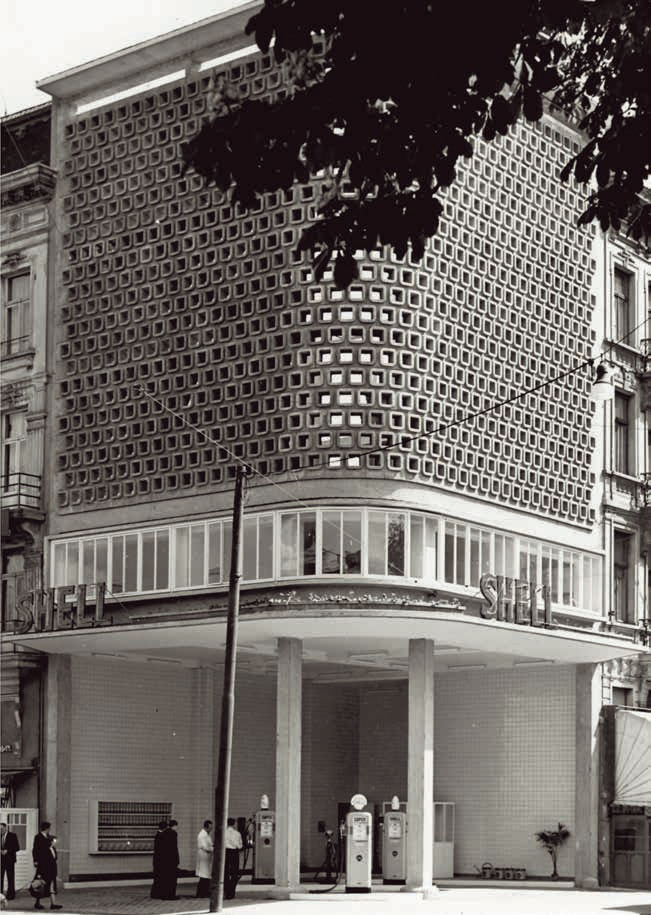Filling up in the city
The typological evolution of service and petrol stations in Antwerp, 1945-1975
DOI:
https://doi.org/10.48003/knob.122.2023.1.777Downloads

Abstract
The global automotive industry has undergone major developments in the last decade, perhaps the most decisive transformations in its one hundred-year existence. The current fundamental transition from a fossil fuel-driven motor to an electric power source heralds the end of an era. This revolutionary change is perhaps a good time to reflect upon the past one hundred years of fossil-fuel powered driving and in particular on its very distinctive service architecture. This article provides insight into the evolution from kerbside pump to self-service petrol station within the greater Antwerp area of Belgium in the period 1945 to 1975. It is a condensed version of an architectural-historical research project based on over two hundred building and environmental permits held in the Antwerp City Archives and involving the close study and analysis of a set of parameters. The outcome of this research served as the basis for conclusions about developments in the design of post-war service stations seen in relation to the socio-economic situation and the evolving spatial design of the city of Antwerp. In situ research into the current state of those buildings or locations resulted in an inventory of surviving examples of this built heritage which could serve as basis for further revaluation and, ultimately, protection of part of this built heritage.
References
Dit artikel is gebaseerd op onderzoek dat ik verrichtte in het kader van mijn masterscriptie, onder begeleiding van prof. dr. Inge Bertels en dr. Joeri Januarius: ‘Station to Station. An architectural-historical analysis of the Antwerp service- and filling stations, 1945-1975’, Universiteit Antwerpen, 2022.
E. Foner en J.A. Garraty (red.), The Reader’s companion to American history, Boston 1991.
P.J. Hugill, ‘Good roads and the automobile in the United States 1880-1929’, Geographical Review 72 (1982) 3, 327–349.
M. Hubert, ‘Expo ’58 en “Koning Auto”. Welke toekomst voor de grote wegeninfrastructuur in Brussel ?’, Brussels Studies 22 (2008), 1; https://journals.openedition.org/brussels/624.
Hubert 2008 (noot 3), 319.
A. Jakle en D. Sculle, The gas station in America, Baltimore 1994, 146.
Stadsarchief Antwerpen (SAA ), bouwdossiers 956#4805 en SAA bouwdossier 956#4815.
Jakle en Sculle 1994 (noot 5).
S. De Caignie, Bouwen aan een nieuwe thuis. Wooncultuur in Vlaanderen tijdens het interbellum, Leuven 2010, 116.
R. Vahlefeld en J. Friedrich, Garagenund Tankstellenbau. Anlage, Bau, Ausstattung, München 1953.
Gazet Van Antwerpen, 25 juli 1973, 20.
SAA, bouwdossier 103#3238.
SAA, bouwdossier 103#3238.
SAA, bouwdossier 103#3536.
De claustra-techniek werd oorspronkelijk gebruikt ter ventilatie van Romeinse badhuizen. Later gebruikten de Moren in Spanje in de achtste tot en met de twaalfde eeuw geometrisch opengewerkte marmer-, gips- of terracotta elementen als zonnescherm. Een zeldzaam vroege twintigste-eeuwse toepassing vinden we in de Notre- Dame de Raincy van architect Auguste Perret (1923).
SAA, bouwdossier 802#6881.
SAA, bouwdossier 957#2141.
N. Grande, ‘The Baghdad Affair. How diplomacy supplanted one of the last major projects by Le Corbusier’, paper gepresenteerd op congres ‘Le Corbusier. 50 years later’, Valencia, November 2015; dx.doi.org/10.4995/LC2015.2015.645.
Bijna elk nieuw servicestation in de stad werd met foto in de lokale pers vermeld.
J. Van den Broeck e.a., Antwerpen herwonnen stad? 1940-2012, Brugge 2015, 163.
P. Lombaerde, P. ‘Architectuur, stedebouw en verkeer’, in: Genootschap voor Antwerpse Geschiedenis, Antwerpen in de 20e eeuw. Van Belle Epoque tot Golden Sixties, Brasschaat 2008,
-234, 233.
E. Katsoulis, De erfenis van de harde stadsvernieuwing na WO II, masterproef Rijksuniversiteit Gent, 2016, 22.
J. Hertoghs, ‘De jukebox van de weg. De teloorgang van de tankstations (1)’, Humo 4005/24 (2017), 141.
SAA, bouwdossier 180#3666.
SAA, dossier 956#4782: briefwisseling tussen architect J.R. Bossaerts en het gemeentebestuur van Berchem, september 1946.
Lombaerde 2008 (noot 20), 213.
Archief ExxonMobil, Rotterdam, 47: Handleiding voor Service- en Fillings Stations, uitgave van de Standard Amerikaansche Petroleum Comp. N.V., gebouw ‘Petrolea’ Den Haag, [1947].
SAA, bouwdossier 18#56233. L.on Palm ontwikkelde samen met architect Willy Van Der Meeren (1923-2002) in 1954 het EGKS-huis, vernoemd naar de opdrachtgever, de Europese Gemeenschap
voor Kolen en Staal (EGKS); Agentschap Onroerend Erfgoed 2022: Wooncomplex met architectenwoning
Willy Van Der Meeren, id.erfgoed.net/erfgoedobjecten/201211 (10 maart 2022).
‘Voordelig tanken met zelfbediening: Gulf Express Centers’, Gazet van Antwerpen, 27 januari 1976, 10.
SAA, bouwdossier 103#2036.
Onafhankelijke pomphouders zijn niet contractueel verplicht om bij één petroleummaatschappij een minimale hoeveelheid brandstof voor een bepaald prijsniveau aan te kopen, maar bevoorraden zich op de vrije markt.
Artikel 5.6.2.1.1. paragraaf 2 van Besluit van de Vlaamse regering van 1 juni 1995 houdende algemene en sectorale bepalingen inzake milieuhygiëne.
Stad in Cijfers, databank. Woningen volgens bouwjaar, stadincijfers.antwerpen.be/databank/ (10 maart 2022).
Published
How to Cite
Issue
Section
Articles
License
Copyright (c) 2023 Thomas Vanhaute

This work is licensed under a Creative Commons Attribution 4.0 International License.





